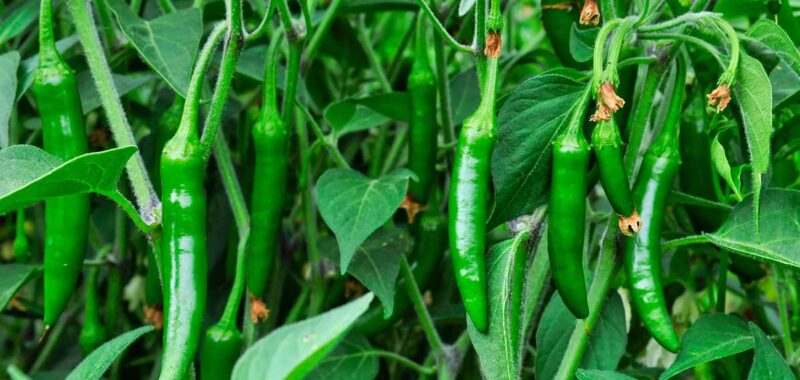Capsicum annuum ‘Serrano’
Looking for more heat than jalapenos offer, but you don’t want a pepper so spicy it will melt your tastebuds? Hello, serrano!
These peppers are popular for a reason. The good amount of heat they offer doesn’t overpower their pleasant grassy flavor, and the juicy flesh is the perfect thing for salsas and sauces.
You can cook with them or eat them raw right off the plant. Either way, you’re in for a treat.


We link to vendors to help you find relevant products. If you buy from one of our links, we may earn a commission.
Growing them yourself gives a measure of control over the heat level and you can decide whether to harvest them young and green, or wait until they’re mature and red when the spiciness has mellowed a bit.
We’ll cover all the tricks to know when growing this staple of Mexican cuisine. Here’s what to expect:
Serranos hail from Mexico, where they are the second-most popular pepper after jalapenos.
They originated in the mountainous states of Hidalgo and Puebla, and their name is derived from the word sierra, the Spanish term for “from the mountains.”
Quick Look
Common name(s): Serrano pepper
Plant type: Perennial vegetable (grown as an annual)
Hardiness (USDA Zone): 9-12 (as a perennial)
Cultivated in: Mexico
Season: Summer
Exposure: Full sun
Soil type: Organically rich, sandy, well draining
Soil pH: 6.0-7.0, slightly acidic to neutral
Time to maturity: 70 days
Spacing: 18 inches
Planting depth: 1/4 inch (seeds), depth of root ball (transplants)
Mature size: 1-2 feet wide x up to 5 feet high
Water Needs: Moderate
Serrano peppers are part of the Capsicum genus. Botanically, they are chilies, not peppers. True peppers are plants in the Piper genus, with black pepper – the one we harvest black pepper seasoning from – being perhaps the most famous.
The plants can grow up to five feet tall, but I’ve never had one reach more than half that. Even still, you can easily harvest four dozen or more fruits off of one plant in a season.
They are typically eaten when they’re green. The fruits grow between one and four inches long and about half an inch wide.
If you leave them to mature on the plant, they’ll turn red, yellow, brown, or orange. They’re long and tapered, and look similar to a jalapeno but with a pointier tip. They have thick flesh and thin skins, with a grassy, spicy flavor.
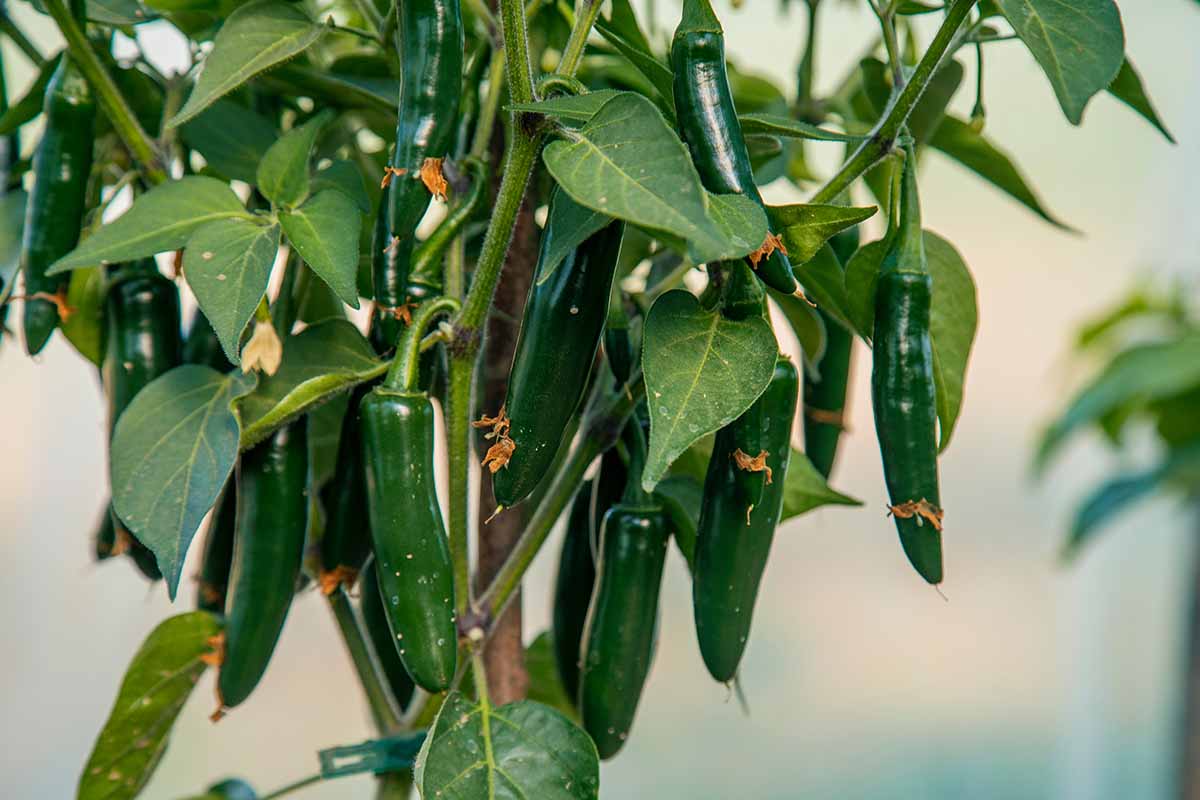

In the US, serrano sales take a distant backseat to jalapenos, but they’re still one of the most popular chilies.
Most gardeners grow peppers as summer annuals, but they can be grown as perennials in warmer zones. More on that a bit later, so keep reading!
Propagation
If you decide to propagate seeds from the fruits of plants you have grown yourself, keep in mind that peppers cross-pollinate incredibly easily.
If you had a bell pepper plant and a serrano plant growing near each other last year, the seeds from the serrano fruits might not produce the results you expect.
This ability to cross-pollinate is one of the reasons why we have so many fabulous varieties of peppers to choose from today, but it can also present a gardening challenge.
If you need to be absolutely certain that you’re planting the cultivar you want to be growing, purchase seeds or seedlings, or make sure your plants are well isolated from one another.
From Seed
Peppers are fairly easy to start from seed, provided you have bright light (or supplemental lighting) and a heat mat. If you have both, then start prepping about eight weeks before the last predicted frost date in your area.
If you need to pick up a heat mat, Vivosun makes a reliable option that is adjustable, unlike some other mats on the market.


Vivosun Heat Mat
Grab one at Amazon.
Use a compostable peat pot, or even better, choose manure pots instead. CowPots are made out of an extremely renewable resource (cow poop) and they biodegrade right into the soil when you plant them, adding nutrients and leaving no waste behind.
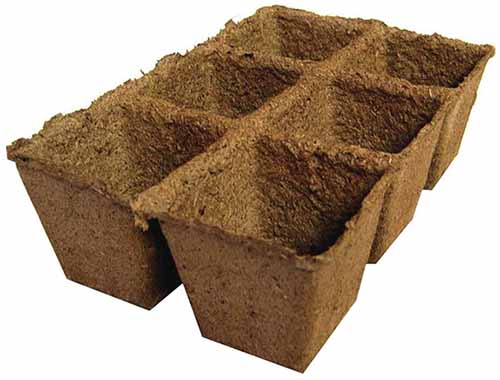

CowPots Biodegradable Pots
Use a three-inch six-cell or individual three-inch pots. If you’re looking for a good place to pick them up, Arbico Organics carries CowPots in both sizes.
Here’s how to start them:
- Fill the pots with seed-starting mix and place a seed a quarter-inch deep in the medium in each cell or container.
- Place on a heat mat where the seeds will be able to receive at least 12 hours of light a day, preferably 16 hours, once they germinate. This might mean using grow lights is necessary.
- Keep the soil moist but not wet as the seeds germinate and the seedlings emerge. This will take about two to three weeks.
- When the outdoor nighttime low temperatures are around 50°F and the seedlings have at least two sets of true leaves, you can transplant your peppers outside after hardening them off.
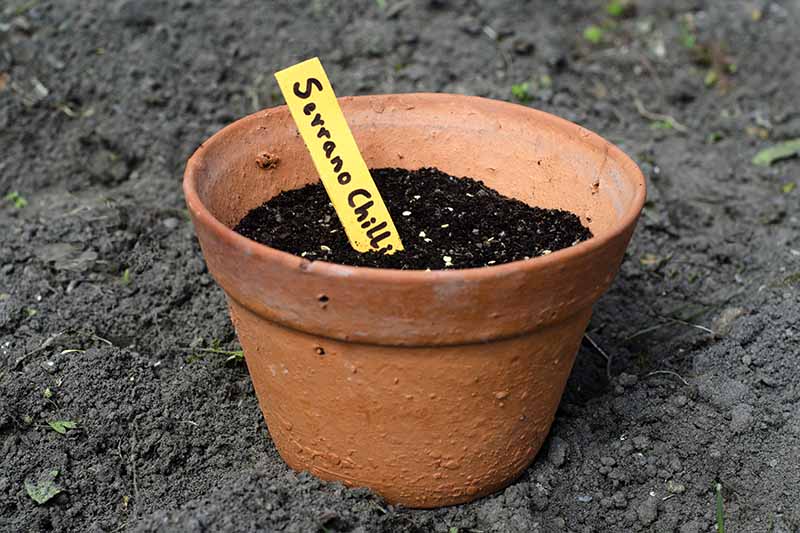

Hardening off involves placing the seedlings outside in a protected area with dappled sunlight for an hour and then bringing them back into the safety and more mild conditions of home.
The next day, give them two hours in the great outdoors. Keep adding an hour each day until a week has passed. Now you can plant them in the garden.
Transplanting
Whether you purchase your plants as seedlings from local stores or grow them from seeds, the transplanting process is the same.
Amend your soil, if necessary, by adding lots of well-rotted compost. Peppers like sandy, well-draining soil, while heavy clay is a chili killer.
You will need to amend the soil at least two feet down and wide.


Here’s how to plant them:
- Dig a hole just slightly wider and the same depth as the container that you started your seeds in or that the plant came in. Gently loosen the plant and remove it from its pot.
- Place the seedling in the hole that you dug. Of course, if you grew your own peppers in biodegradable pots, there’s no need to remove them from the container.
These plants need about 12 to 18 inches between them to grow to their full size without being too crowded. Crowded plants are more susceptible to pests and diseases.
Serranos can also be grown in three-gallon containers, though a five-gallon capacity is preferable. Be sure to choose one with a drainage hole in the bottom.
Water the soil well until it is saturated but not muddy. Keep young plants moist and gradually reduce watering as the plant matures.
How to Grow
Serrano peppers are relatively low-maintenance once established, and they reward gardeners with a steady supply of crisp, hot pods that are perfect for salsas and pickling.
Give them a spot that’s sunny, warm, and protected from strong winds, and they’ll thrive.
Let’s break down what they need for healthy, productive growth:
Light
These peppers demand full sun, meaning they need at least eight hours of direct sunlight each day.
More light generally means more fruit—and spicier ones at that. In cooler or cloudier climates, consider using reflective mulch or placing them near a south-facing wall to maximize sun exposure.
Soil
Loose, organically rich soil with excellent drainage is best. They prefer a pH between 6.0 and 7.0, which is slightly acidic to neutral.
Before planting, amend the soil with well-rotted compost or aged manure to provide a good nutrient base.
Avoid heavy clay soils or overly sandy ground, which either retain too much water or not enough. Raised beds can help if you’re dealing with poor native soil.
Water
Water them regularly so the soil’s moist but not wet. When the top inch of soil dries out, it’s time to add more water. Water is especially important when plants are young, and up until the fruits form.
Mulch is extremely helpful to retain water. Place an inch of straw or compost around the plant, but leave an inch free around the circumference of the stem.
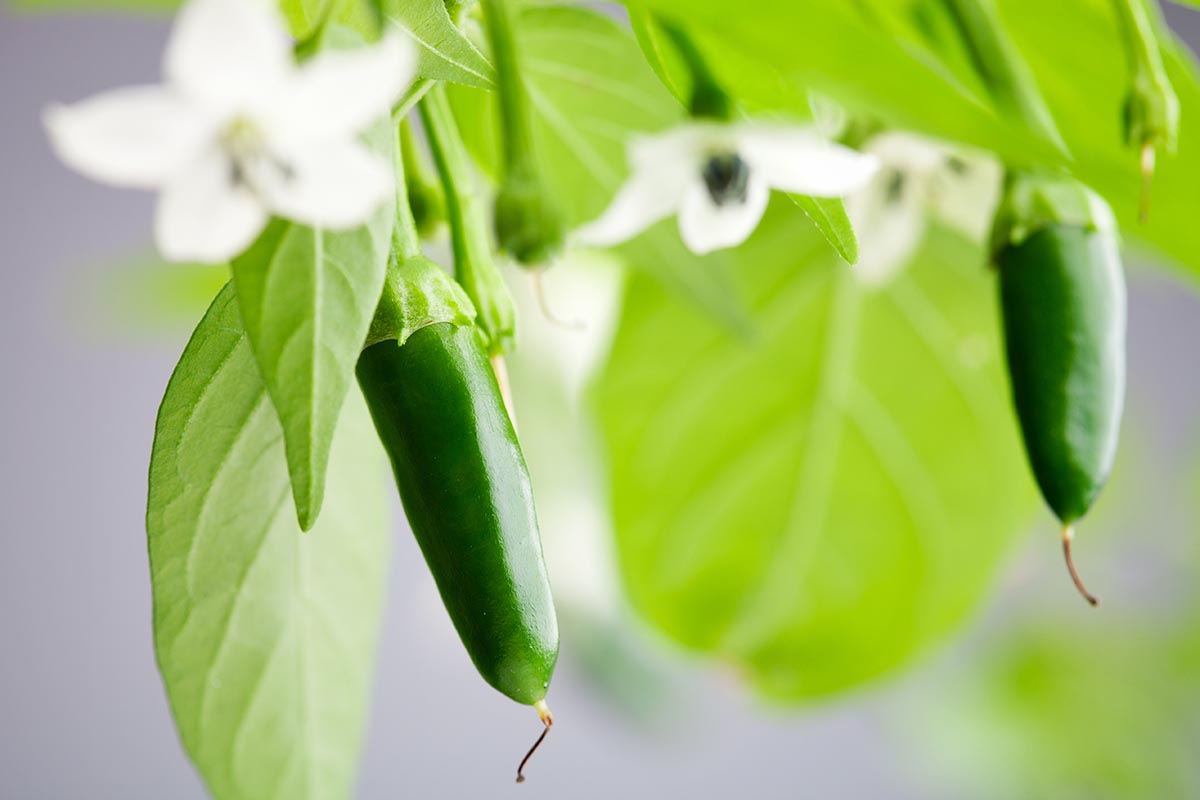

Temperature and Humidity
Remember, peppers come from places that are nice and hot. Ideal temperatures are between 70 and 85°F during the day and no lower than 50°F at night.
If you have a surprise weather event that threatens a dip in temperature, cover your plants with a blanket or cardboard. Floating row covers can help to regulate temperatures in areas that tend to experience fluctuations.
If you live in an area that doesn’t have extremely warm summers, you might want to place your peppers somewhere they can receive heat that’s reflected off of a building. Brick is ideal for this.
They’re tolerant of average humidity but need good airflow to prevent disease, especially if you live in a more humid area.
Fertilizer
Fertilize with a low-nitrogen fertilizer with something in the range of 5-10-10 NPK to encourage fruit formation rather than foliage.
Container Growing
Serrano peppers are well-suited to containers, provided you use one that is at least five gallons in size with drainage holes. Use a moisture-retentive, well-draining potting mix.
Container-grown peppers may dry out faster than those grown in-ground, so check the moisture level frequently and water more often during hot weather.
Place the container in a sunny, sheltered spot and rotate it regularly to ensure even growth.
Cultivars to Select
Often, you’ll simply find these plants sold under a generic name.
For instance, Eden Brothers has heirloom seeds available in small packets, one ounce, or quarter-pound containers.
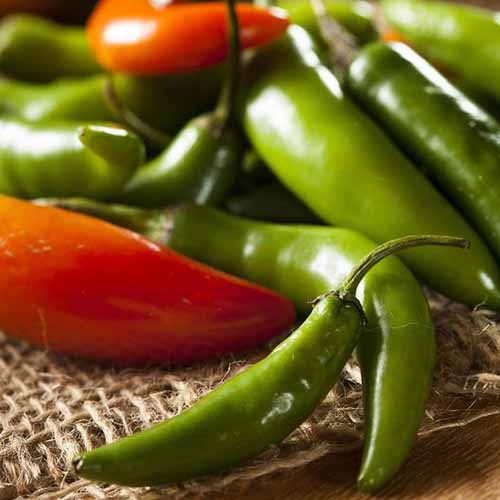

Serrano Peppers
But if you keep an eye out, there are several hybrids and cultivars available as well that can offer you some different options.
NuMex CaJohns Serrano
This cultivar is huge, with a capital H. Bred at the Chili Pepper Institute in New Mexico, it reaches at least four inches long, but often several inches longer.
The pods are about an inch wide at the widest spot and the plant is extremely high-yielding.
However, this isn’t the plant for you if you’re looking for spice. The fruits top out around 5,000 SHU, making them closer to a jalapeno in terms of heat level.
Purple
Yes, this one stands out because the fruits are deep, dark purple, but they’re also longer and thinner than the standard serrano.
You must let the peppers mature on the plant to attain that dark color. Otherwise, pick them when they’re green – they’re still delicious.
Serrano del Sol
If you’re hoping for some peppers early in the season, this hybrid is a good option.
The lateness of ripening is one of the big complaints gardeners often have about serranos, but these fruits are ready starting just two months from planting. The plants are high-yielding as well.
Tampiqueno
Bred in Guanajuato, Mexico, this heirloom has medium-spicy, petite fruits that stay under two inches long. You can start harvesting in about 75 days.
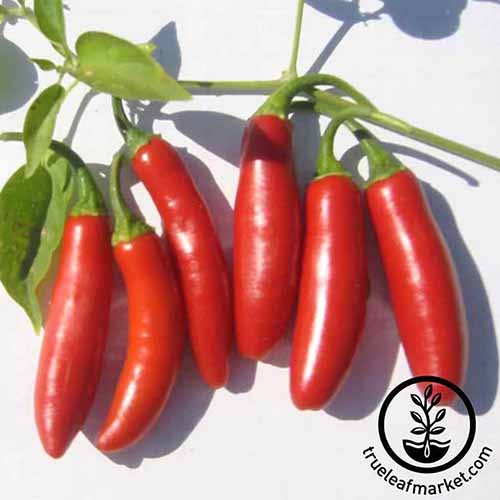

‘Tampiqueno’
True Leaf Market carries this classic in various packet sizes ranging from one gram to five pounds of seed.
Maintenance
If you live in Zones 9b to 12b and you plan to grow your plants as perennials, prune them hard during the winter. You want to prune them back by half.
If the temperatures dip below 35°F, bring them indoors or cover them in blankets or cardboard. Our guide to overwintering peppers has more information.
In the second year, you’ll likely see a big, bountiful harvest. The number of fruits that grow on your plant will start to decline in the third year.
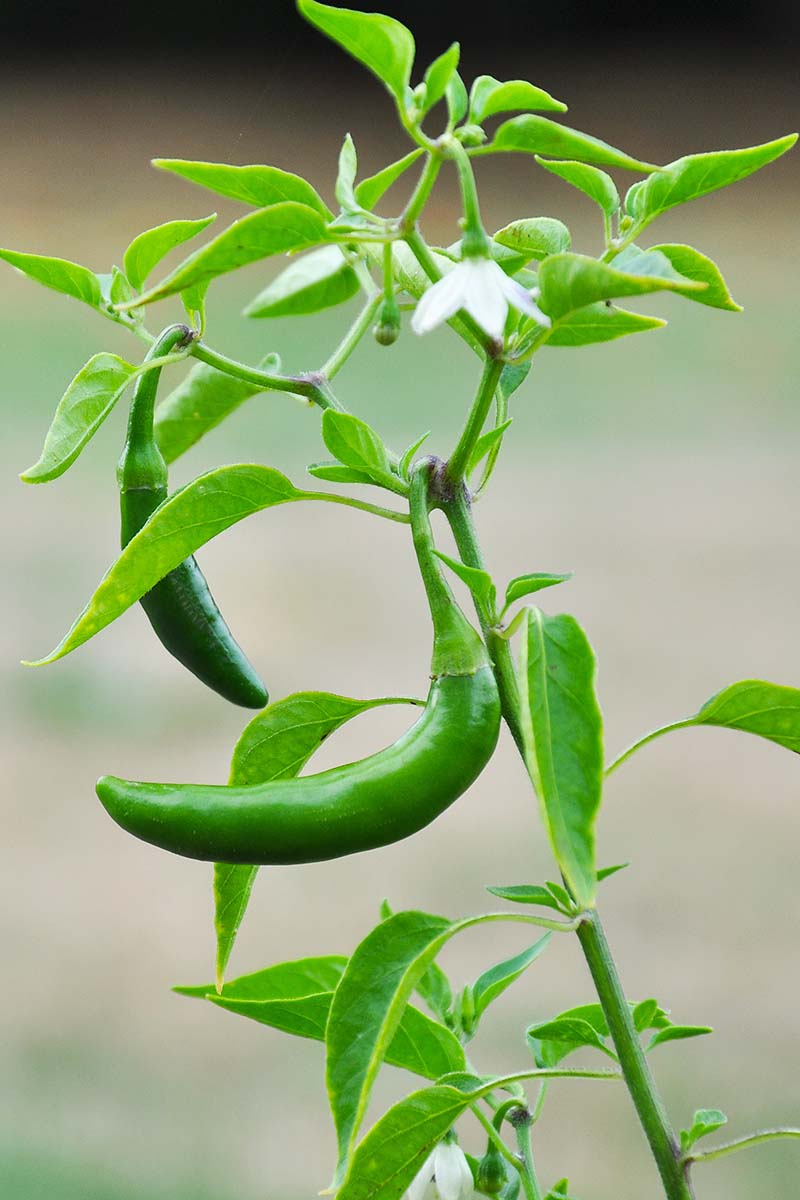

That doesn’t mean you must pull the plant. If you particularly love the one you have, keep it growing, but temper your expectations and maybe plan to save seeds from the fruits so you can continue its legacy.
If you find your plants are starting to lean or droop, attach stakes around them for support.
Feel free to pinch the growing shoots to encourage bushier growth. This isn’t necessary for a nice harvest, but you can influence the shape of the plant through pinching.
Peppers grown as annuals can be removed from the garden and composted at the end of the season, with the arrival of first frost.
Pests and Disease
Apparently, deer, rabbits, and other herbivores don’t appreciate the spice of chilies in the same way that humans do.
In fact, that’s probably the main reason peppers evolved to contain capsaicin in the first place. It discourages herbivores from taking a bite and preventing the plant from reproducing.
The fact that these plants have been spread across the globe by humans is often due to the fact that they do contain capsaicin, so it was an unintentionally successful evolutionary trait in that sense. But I digress
Insects
You were probably hoping that if herbivores don’t like chilies, pests might not like them either. No such luck. Not only do several types of insects love to devour pepper plants, but they can also spread disease.
Aphids
Aphids are common on pepper plants and there are many species of aphids that feed on them. Aphids are sap-sucking pests in the superfamily Aphidoidea. If you’ve gardened much, you’ve probably come across them at least once before.


In peppers, you’ll notice yellowing leaves and a sticky honeydew on the stems and foliage.
Read our guide to learn how to identify and eliminate aphids.
Flea Beetles
Flea beetles (family Chrysomelidae) love plants in the Solanaceae family. That includes things like eggplants, tomatoes, and, yes – peppers.
They are tiny, shiny, black beetles that chew little shot holes into the leaves of the plant, which can reduce vigor and introduce disease.
Head to our guide to learn more about controlling flea beetles.
Spider Mites
Pepper plants like it warm and dry. Unfortunately, so do spider mites.
You probably won’t notice the tiny insects on your plants. Instead, you might see the webbing they leave behind, and yellowing leaves.
When enough of them are present, this causes severely stunted growth and may even prevent fruits from fully developing.
Learn more about spider mite control here.
Need more help? Check out our guide to pepper plants pests.
Disease
I find pests to be a more common problem with serranos than disease. But pests won’t usually kill your plant, and diseases can.
Damping Off
Damping off is something pepper plants may experience when they’re young. Either the seeds won’t germinate at all, or the seedlings will be weak, and collapse. You might notice a dark, water-soaked stem just above the ground.
It’s caused by several different types of fungi and water molds (oomycetes), including Pythium and Rhizoctonia species. Check out our guide to understand why damping off happens and how to prevent it.
Mosaic Virus
Pepper mosaic virus (PMMoV) is caused by tobacco viruses in the Tobamovirus genus.
The plants can also be impacted by cucumber mosaic virus (CMV) and tomato spotted wilt virus (TSWV). Regardless of the specific pathogen that strikes, the symptoms all look the same.


Leaves will have yellow, angular blotches and slightly puckered sections. The fruit will have unusual lumps and bumps. Once plants are infected, there’s nothing you can do.
Prevent disease by keeping insects like aphids away, because they can carry these viruses. They can also be carried on contaminated seed, clothing, or tools. That’s why it’s important to practice good garden hygiene.
Powdery Mildew
Powdery mildew is commonly seen in many different species of plants. It’s caused by fungi in the order Erysiphales and results in a powder-like coating on the leaves of infected plants.
It can be spread in a number of ways, by aphids, moisture, and wind, to name a few. Stressed plants are particularly vulnerable.
Read our guide to powdery mildew for
Harvesting
Do you know how sometimes you bite into a pepper and it’s perfectly spicy, but you try another from the same plant and it blasts your taste buds into outer space?
There are several factors that can alter the heat of a chili on the same plant, but the position on the branch is one of the major contributing factors.
The fruits on the first node are the least spicy, with those on the second node being spicier.
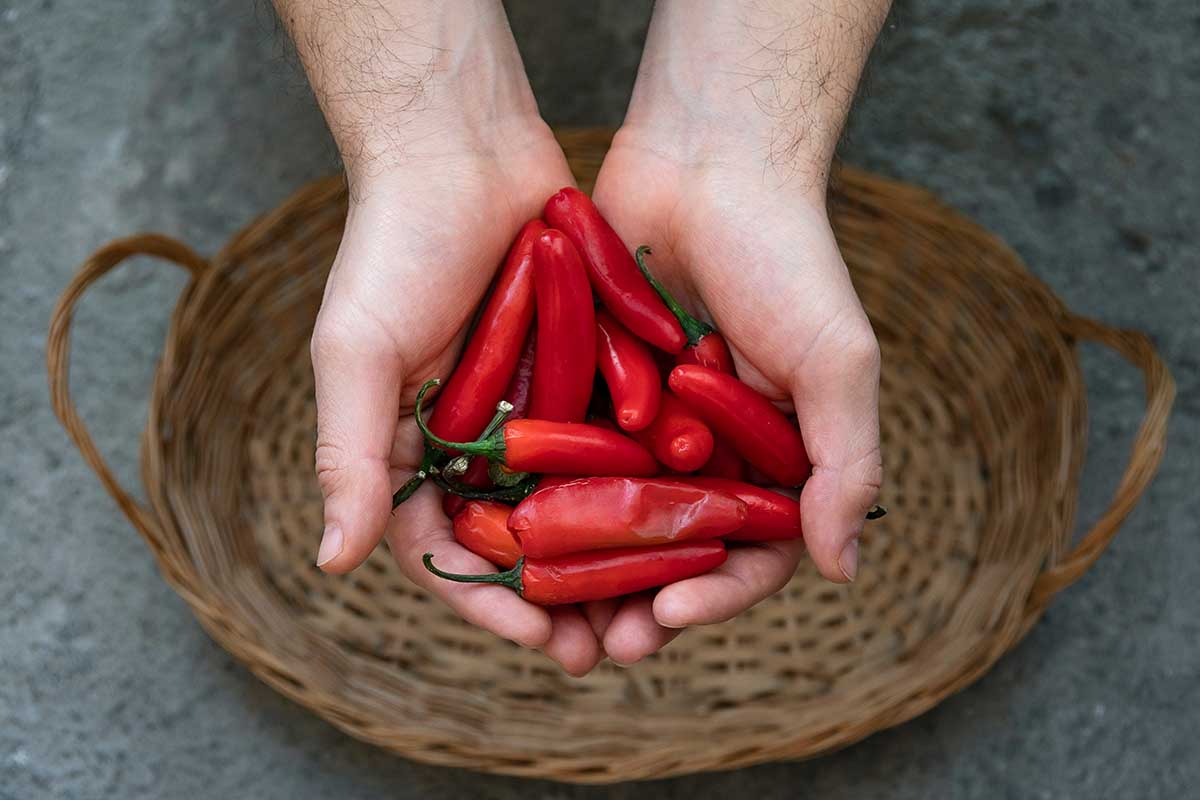

If you have varying levels of heat preference, sort your peppers as you pick them according to the node they came from. I’m happy to provide my address if you want to keep the ones from the first node and send those spicier suckers my way.
Like Things Spicy?
If you like your peppers spicy, there are a few things you can do to ensure extra heat:
- Feed plants with a high-nitrogen fertilizer.
- Reduce watering after the fruit has set – water when leaves just start to droop, but not before.
- Let the peppers reach their mature size (around 70 days) and then harvest. They shouldn’t be left to mature further on the vine. Once the color starts changing from green, the pepper starts becoming milder.
To harvest, gently pull the peppers by hand. They should come away easily if they’re ready. You might need to use scissors or clippers if you’re harvesting them a bit before they’re fully mature.
Make sure to leave plenty of stem attached if you want to hang them to dry.
The peppers might not all mature at the same time, so keep an eye on things and pick them individually when they seem ready. Use the number of days to maturity for your selected cultivar as a guide, and check your plants regularly.
Serranos Add Pep to Your Garden
Serranos are versatile peppers, which is why they should be a staple in your veggie garden. Plus, growing them yourself gives you a measure of control over how spicy they are when you harvest them.
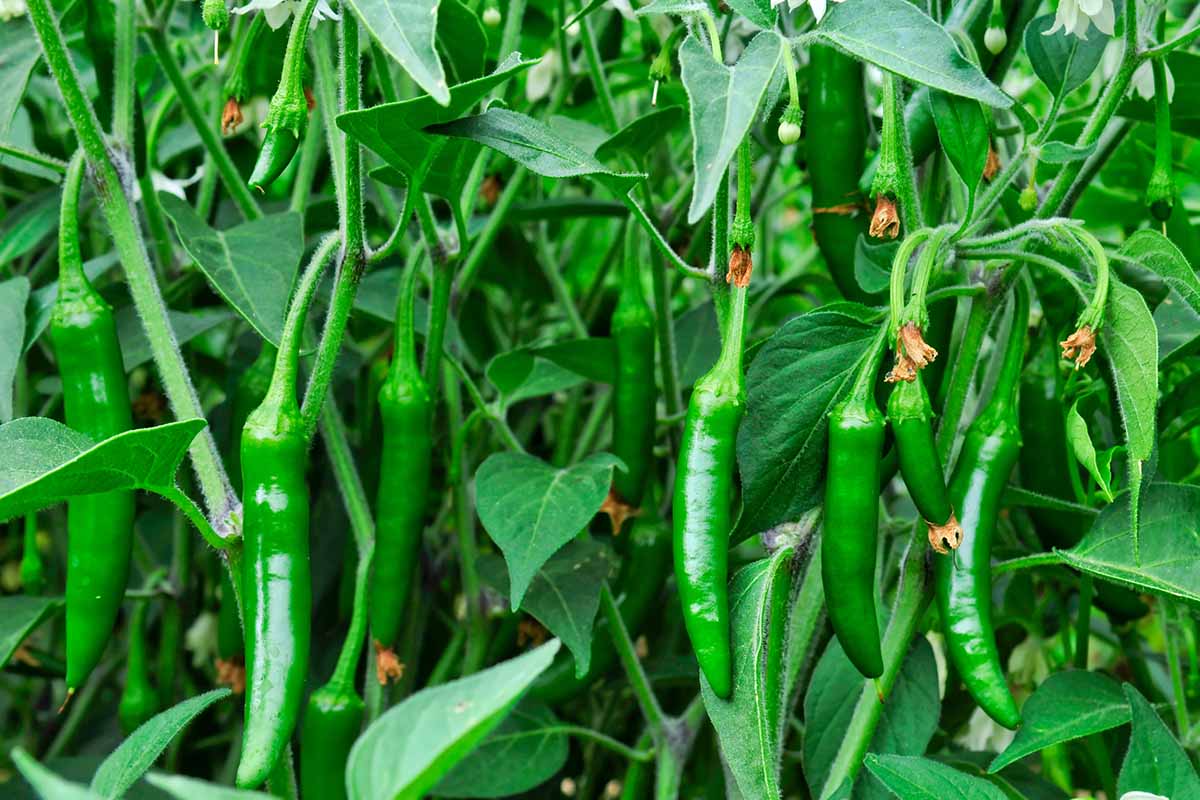

And you know there’s nothing better than plucking a pepper off the plant and popping it into your mouth while it’s still warm from the sun.
How do you intend to use up your serrano bonanza? Let us know in the comments.
I hope that this guide helped you feel confident about growing these marvelous plants. If you’re interested in growing other peppers, you might be interested in these articles:

